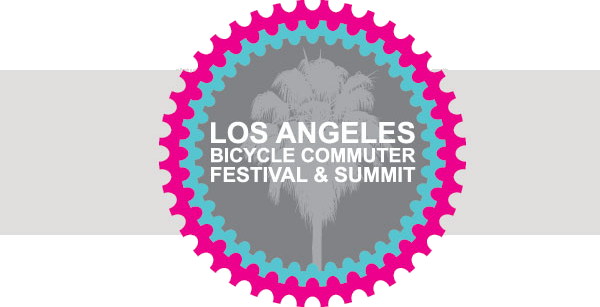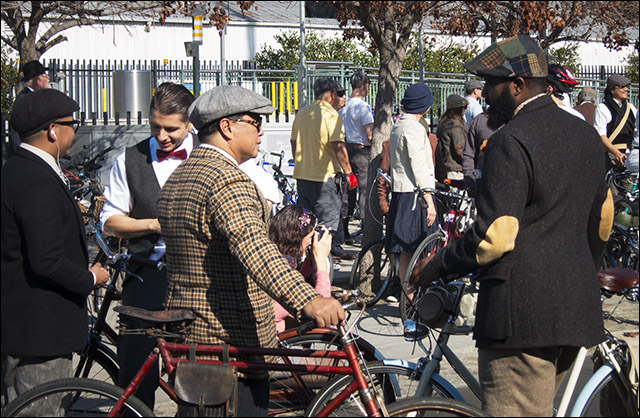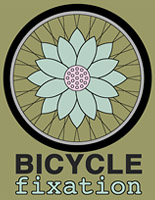Today's ride was particularly gratifying, since, despite the weather, there were, as usual, more cyclists than motorists along Fourth—and this time I rode the entire length of the bike route, rather than turning off halfway along. Usually bikes outnumber cars on the western half, and it's about even on the eastern half, but today velos led all the way! Considering how thoroughly deteriorated much of Fourth's road surface is—and even the freshly-paved sections are starting to break up, though it's been well under a year since the blacktopping—this shows not only that cycling's mode share is rising steadily, but that Council Member Tom LaBonge's withdrawal of support for the bicycle-friendly street treatment for Fourth several years ago was just plain foolish. The street has been a bike route for forty years, bike traffic is rising on it week by week, and it is an ideal connector between the near west side and downtown. It needs little more than repaving and some roundabouts and diverters to filter out the manic speeders who occasionally slop over onto it from Third and Sixth to become a centerpiece bicycle facility for Los Angeles. And it needs the repaving anyway, as it's rough even for SUVs.
Nevertheless, LA's cyclists steadfastly pedal along it, a silent parade of men and women in fairly even numbers, ranging in age from gamins to grannies.
The joy didn't end when I shunted over to Sixth Street up at Hoover. Sixth is far busier than Fourth, four lanes, and runs along commercial blocks; furthermore, it's surface is also treacherous. Yet nearly every bike rack I saw between Vermont and Figueroa was occupied. Possibly most of the riders found their way there along nearby Seventh, which has very good bike lanes now. In any case, there they were.
Chill air, a definite taint of smog, and LA's usual crush of traffic didn't hold folks back from putting ass on saddle and heading out into the world. Good for them, I say! And good for LA too.
Richard Risemberg on Fri, 31 Jan 2014 01:53:35 -0800 [link]

AIDS/Lifecycle and the Bicycle Culture Institute announce a day-long festival and summit to entertain, educate, connect and inspire bicycle commuting in Los Angeles.
February 16, 2014
The Village At Ed Gould Plaza
1125 North Mccadden Place
Los Angeles, Ca 90038
- Festival environment to connect with rides, community groups and brands.
- Indoor and outdoor workshops on fun DIY beginner topics.
- $10 tickets include panels, workshops, festival and healthy snacks.
- Press conference at noon
Riding bikes is fun! AIDS/Lifecycle and the Bicycle Culture Institute bring together everyone you need to learn about rides, local groups, advocacy, staying safe and getting inspired. The festival is focused on connecting the most innovative and friendly cycling folks and teaching new bicyclists (or helping sport/recreational riders) learn the basics of riding for transportation.
We encourage everyone to bring friends and family; enjoy indoor and outdoor workshops, and two open air festival areas. Festival areas encourage talking directly with people representing local bike groups: from cicLAvia and the Los Angeles County Bicycle Coalition to L.A. Bike Trains and SoCal Cross; cycling brands BERN, Abus and Lezyne; local favorite commuter bike shops Orange 20, Flying Pigeon and many more.
Tickets are only $10 and include full access to opening panel, workshops, both festival areas and some food/beverage options. Tickets are available at Brown Paper Tickets in advance, and at the box office. An amazing silent auction will allow attendees to bid on the coolest new 2014 bike stuff. Proceeds to benefit the Bicycle Culture Institute's projects including L.A. Bike Trains.
SCHEDULE:
12:00-12:45 Press Conference - festival areas open
1:00-1:45 Opening Panel
2:00-2:45 Workshops Round 1
2:45-3:30 Break: explore & "snack time!"
3:30-4:30 Workshops Round 2
5:00-6:00 Closing Remarks/ Raffle Winner announced
6:00-7:00 Party & Open festival
Facebook Page
Hashtag: #LABikeFest
Richard Risemberg on Thu, 30 Jan 2014 04:35:18 -0800 [link]
Meanwhile, across the river and over the hills in NE Los Angeles, it's Regime Change vs Messy Democracy as freshman council member Gil Cedillo gives the impression that he's stonewalling previous council member Ed Reyes's projects, despite community and council approval.
Richard Risemberg on Wed, 29 Jan 2014 19:12:59 -0800 [link]
One thing I don't like is that most of them are riding on the sidewalks. This is legal in Los Angeles but ineffective, unsafe, and often rude. Some of these folks are moving rather quickly—I remember one from last week who was going about the same speed that I was, and I was on my bike in the street and am not a plodding rider by any means. The Mile sees a lot of foot traffic (often including me); it has a walk score of 91, and the sidewalks are busy, especially around lunchtime or near the museums.
True, its bike score is only 59, but that's not so bad. Wilshire is daunting, though: lots of traffic, often fast (despite the traffic lights every two or three hundred feet), lots of scofflaw motorists. Still, it's not as bad as it looks. I pedal it often, sometimes even at rush hour, and it's one of the busiest streets in the country. But it looks pretty bad when you're waiting to sprint into the flow of traffic, so I understand.
That will change soon, at least during the commute crush: the street is gaining rush hour bus/bike lanes, which aren't as bad as some would contend. There used to be a pair of them downtown, on Spring and on Main before they won genuine buffered bike lanes (even if buffered only by paint), and Wilshire already has a set up in Koreatown. They exist in several other US cities as well, plus Britain, France, and Germany, where their safety record is very good.
Whether they will feel safe enough for the "interested but concerned" who are steadily filling the streets, I don't know, but the accompanying "Bikes Okay" signs may draw a few of the bolder timid into the laneways…at least when there isn't a massive articulated bus bearing down.
And as I said, riding the sidewalks is legal here; the stipulation is that one simply be polite. More bikes is more better, and I'm glad to see them…and to join them, when I'm going farther than two or three blocks.
Richard Risemberg on Sun, 26 Jan 2014 06:26:41 -0800 [link]
Then hop over to Flying Pigeon LA for a report on some Hot Tweed Action in NE Los Angeles….
Richard Risemberg on Tue, 21 Jan 2014 17:45:44 -0800 [link]

Went on another Tweed Ride last Sunday, and passed the afternoon surrounded by people wearing clothes that they believe hearkened back to a vague period between the ascension of Queen Victoria to the British throne, and the end of the Jazz Age.
Although Tweed Rides began as a conscious reaction to Lycra racing kit culture, I find it amusing that it feeds on the same underlying desire: that of dressing up in semiotic costumes. Impractical ones as well, at least on this ride, when the temperature was 85°F.
This is one of the constants of human culture: even functionally Paleolithic tribes who live naked in rainforests still wear things: they may not cover their genitals nor indeed much of their skin at all, and they have no need of protection from the weather or from industrial workplace hazards, but they still dress up. Penis gourds, bones and feathers, paint and string: no matter how skimpy a people's material culture, a good part of it is dedicated to costuming.
Even my own typical ensemble of black and dark gray, conceived as an anti-costume, is a type of costume. Of course.
I have a friend, a collector, who owns fifty bikes of various vintages—and the correct jerseys to match, be they embroidered wool or imprinted spandex. He also wears the correct shoe for each bike, though that sometimes requires nailed-on wooden cleats.
Everywhere in life, people wear special clothing for "special" tasks, which are often not really special. Motorcycle clothing is accepted without a second thought, as are yoga clothes. So is the "business suit," though its restrictions have been proven to reduce the wearer's productivity. There are special hats that Christians wear only during Easter services. Hasidic Jews wear heavy gabardine coats meant to ward off Baltic winters. Many mechanics wear coveralls (though when I was a professional motorcycle mechanic I never did.) Hipsters have their skinny jeans, squares Bermuda shorts. It's a silly human trait, but it pervades all our cultures without fail.
So why in cycling has it lately been Lycra bike togs that we have singled out for scorn? "Ride in everyday clothing!" is the new battle cry.
However: everyday clothing—especially the late Victorian everyday clothing beloved of Tweed Rides—is itself costuming. And certainly to early feminists, the exigencies of the bicycle—the necessity to breathe while pedaling, nearly impossible in a corset, for example—were seen as a benefit. The freer clothing required to ride instigated a loosening of the severe dress codes Victorian women were subject to, and was seen as a way to bring greater political and intellectual, as well as physiological, liberty to women.
Yet now "practical" bikes are often defined as those that let people, and in particular women, ride in impractical clothes such as high heels and tight skirts—styles whose purpose is the physical hobbling of the females, and their objectification…just as in the bad old days! Not as bad as bustles and corsets, but still not the best.
I myself do wear "regular clothing" exclusively when I ride, largely because I want pockets and I prefer not to stand out too much more than I already do in everyday situations. I put the term in quotes because I generally don clothes I designed myself and sell on this website, made to accommodate the physical exigencies of riding a bicycle. Most "everyday clothes" were designed to wear while sitting still in a chair or standing still in a presentation room. Riding a bicycle is physical—and of course that is one of its greatest benefits!
Even walking more than a couple of blocks is more physical than office wear can tolerate well. High heels or stiff leather shoes pinch your feet, ties and jackets strangle, and many people who walk to work (or to the subway or bus stop) wear "special" shoes, such as sneakers, and change into heels at work, or carry the coat and tie over their arm till they arrive at the lobby.
But there's nothing wrong with "racing kit" (at least if it's devoid of logos; I detest logowear). In a way it's the most functional clothing of all: designed to free your body to move. Nor is there anything wrong with tweed, if it's cold and your ride is only a couple of miles long. In fact, there's nothing wrong with dressing not for functionality but to "look right" with your race bike—or your tweedy city bike. We all dress to "look right" in some arbitrary situation.
What is wrong is the condemnation heaped by each side on the other, when we're doing the same thing in slightly different ways. Riding bikes, and dressing to play social games.
Richard Risemberg on Tue, 21 Jan 2014 02:22:33 -0800 [link]
While Orange 20 explores the area Beyond the River: the NELA Loop, which this bridge would serve.
Richard Risemberg on Wed, 15 Jan 2014 18:49:13 -0800 [link]
In fact, I saw bikes everywhere as I made my rounds. I pedaled downtown first, to a video shoot for the GRID Logistics project I am part of; then went over the river to visit pal Josef at his shop, forgetting that he's now closed on Sundays; then along the river to Silver Lake. From there I headed home through the gray and shabby avenues of The (Sort Of) Movie Capital of the World, finally easing through leafy Hancock Park with its lawns and mansions.
And in every one of these disparate neighborhoods—some unimaginably wealthy, some heartbreakingly poor, and some of every shade in between—in every neighborhood I saw people riding bikes, often by the half-dozen.
In the very heart of the town that invented Car Kultur, well, that's not too bad!
Richard Risemberg on Mon, 13 Jan 2014 00:05:16 -0800 [link]
While on Flying Pigeon LA's blog, we explore a new bikeway that is visionary only because it's in bicycling backwater Los Angeles: After All That Fuss, we got a paint-buffered lane on Colorado Boulevard….
Richard Risemberg on Wed, 08 Jan 2014 19:37:40 -0800 [link]
Meanwhile, back at the flying Pigeon ranch, I look at El Segundo's Almost Perfect brand-new bike racks.
Richard Risemberg on Thu, 02 Jan 2014 18:03:34 -0800 [link]
 Our sister publication, Sustainable City News, has just published an article on "Portland, Oregon: the Multi-Modal City".
Our sister publication, Sustainable City News, has just published an article on "Portland, Oregon: the Multi-Modal City".This is a follow-up piece to our "Portland 2010: Both More and Less than Paradise", publisher here three years ago after our first trip together to the Rose City, when we focussed on that town's famous bicycle infrastructure.
This time, though we traveled entirely by bicycle or walking we took a broader view of Portland and how it serves all modes of travel—bicycles, cars, walking, buses, light rail, trains, and even barges. And of course the aerial tramway! We also made deliberate efforts to explore all four quadrants of the city
Although in just a week we were not able to go into great depth, we achieved a good overview of a city that has taken some historical advantages—including a small-block grid and a decision in the 1970s to stop building freeways—and built a transportation matrix that accommodates all modes while encouraging the more efficient and community-friendly ones.
The results have been excellent: a generally happy and prosperous city where there's actually room and time to live. As a recent Bikeportland.org article points out, Portland's per-capita GDP has grown significantly int he last ten years, with that growth concentrated in the city center—which also boasts the most bicycle and transit infrastructure.
Though it's become a bit of a national sport to poke fun at Portland lately, the city really has accomplished much that bigger and better-budgeted town should envy. It is worth a good look, so click on over and peruse our reactions and photos at Sustainable City News in "Portland, Oregon: the Multi-Modal City".
Richard Risemberg on Wed, 01 Jan 2014 18:41:29 -0800 [link]



